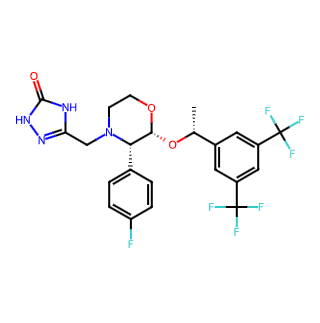- Synthetic anti-infective drugs
- Medications for the digestive system
- Antipyretic and analgesic drugs
- Medications for the blood system
- Medications for the respiratory system
- Anti-allergic drugs
- Medications for the urinary system
- Diagnostic medications
- Immunosuppressive and immunomodulatory drugs
- Vitamins and mineral supplements
- Antioxidants and medications for osteoporosis
- Antiparasitic drugs
- Ophthalmic medications
- Amino acids and their derivatives
- Dermatological medications
- Medications for the circulatory system
- Antitumor drugs
- Medications for the nervous system
- Hormonal and endocrine function-regulating drugs
- Antibiotics
- Others
CAS No.: 170729-80-3




Chemical Information
Chemical Name: Aprepitant
IUPAC Name: 5-([(2R,3S)-2-([(1R)-1-[3,5-Bis(trifluoromethyl)phenyl]ethyl]amino)-3-(4-fluorophenyl)-4-morpholinyl]methyl)-1H-1,2,4-triazol-3(2H)-one
Molecular Formula: C23H21F7N4O3
Molecular Weight: 534.43 g/mol
CAS Number: 170729-80-3
Pharmacological Action
1. Substance P/Neurokinin 1 (NK1) Receptor Antagonist:
o Aprepitant is a selective antagonist for NK1 receptors, which are associated with the action of Substance P. By blocking these receptors, the drug helps to prevent nausea and vomiting, particularly in association with chemotherapy and post-operative recovery.
o Mechanism of Action: By inhibiting the binding of Substance P to NK1 receptors, it reduces vomiting signals in the brain.
2. Chemotherapy-Induced Nausea and Vomiting (CINV):
o Aprepitant is commonly used in combination with other antiemetic agents such as 5-HT3 antagonists (e.g., ondansetron) and corticosteroids (e.g., dexamethasone) to prevent acute and delayed nausea and vomiting caused by highly emetogenic chemotherapy, including high-dose cisplatin therapy.
3. Postoperative Nausea and Vomiting (PONV):
o It is also approved for the prevention of postoperative nausea and vomiting in adults. Its effectiveness in this context extends to both immediate and longer-term prevention.
4. Pharmacokinetics:
o Absorption: Aprepitant has good oral bioavailability.
o Metabolism: Metabolized primarily in the liver by CYP3A4 enzymes.
o Excretion: Aprepitant is excreted via feces and, to a lesser extent, urine.
5. Drug Interactions:
o Aprepitant can alter the plasma concentrations of drugs metabolized by CYP3A4 enzymes. This necessitates caution when co-administered with other medications that are substrates, inhibitors, or inducers of this enzyme.

Tai Yau Street, San Po Kong, Kowloon, Hong Kong, China.



